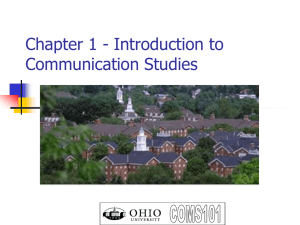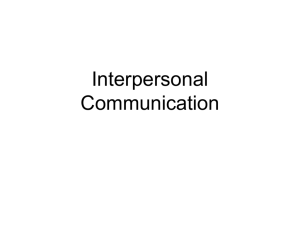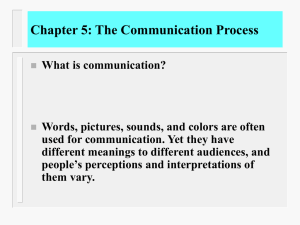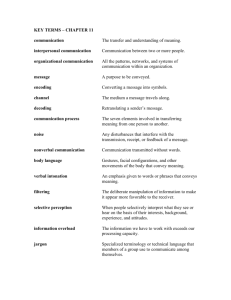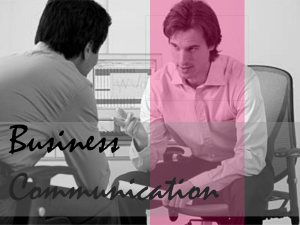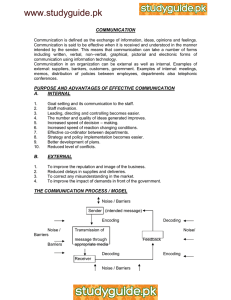Effective Communications for Better Leadership
advertisement
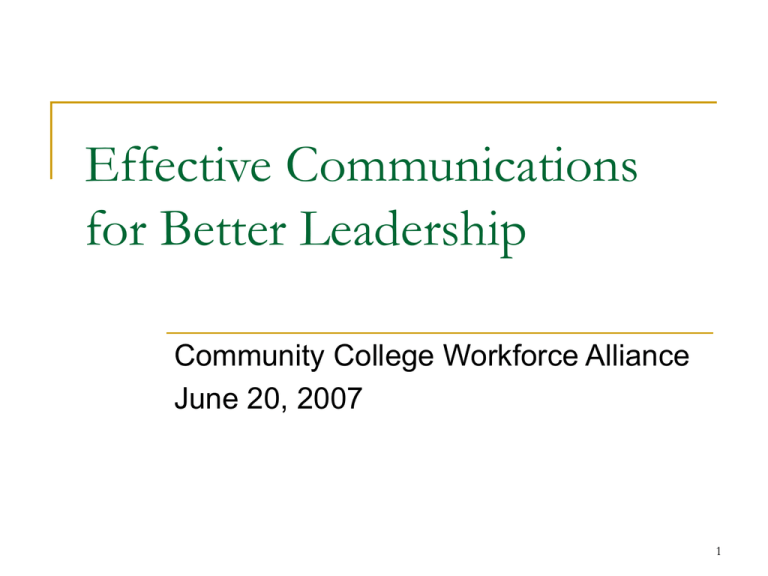
Effective Communications for Better Leadership Community College Workforce Alliance June 20, 2007 1 Learning Objectives Describe the role and importance of communication in the role of a leader for better leadership Identify the basic forms of communication in organizations Discuss informal communication, including its various forms and types Describe how the communication process can be managed so as to recognize and overcome barriers 2 Communications Communication The process of transmitting information from one person to another Effective communication The ability of a leader to transmit a message to the receiver such as a follower, where the message has the same understanding to the receiver as the sender. This message can be verbal or non-verbal 3 Communications Steps in the Communication Process Deciding to transmit a fact, idea, opinion, or other information to the receiver. Encoding the meaning into a form appropriate to the situation. Transmitting through the appropriate channel or medium. Decoding the message back into a form that has meaning to the receiver. “Noise” is anything disrupting the communication process. 4 Communications How to Improve Communications Individual skills Encourage two-way communication Be aware of language and meaning Be sensitive to sender’s and receiver’s perspective Develop good listening skills Organizational skills Follow up Regulate information flow Understand the richness of media 5 Communications Feedback The receiver becomes the sender and the sender becomes the receiver. This is required to verify meaning and complete the effective communication process 6 Types of communications Oral Communication Written E-Mail Non Verbal 7 Barriers to Communication Individual barriers Conflicting or inconsistent cues Credibility about the subject Reluctance to communicate Poor listening skills Predispositions about the subject 8 Barriers to Communications Organizational barriers Semantics Status or power differences Different perceptions Noise Overload 9 Characteristics of Information Accurate A valid and reliable reflection of reality Timely Information delivered in time for managerial action Complete Information that tells a complete story, rather than being incomplete or distorted Relevant Meets the needs and circumstances of the individual manager 10 The Communication Process Noise Sender Start Receiver 2 Encoding 3 Transmission through channels 4 Decoding 1 Meaning Noise 5 Meaning 8 Decoding 7 Transmission through channels 6 Encoding Receiver Sender Noise The numbers indicate the sequence in which steps take place. 11 Informal Communications May or may not follow official reporting relationships and/or prescribed organizational channels and may have nothing to do with official organizational business. Common forms of informal communications are the grapevine, management by wandering around, and nonverbal communication. 12 Informal Communications Grapevine – an informal communication network that can permeate an organization. 13 E-Mails When are they Appropriate? When are they not Appropriate? Legal implications of e-mails Privacy Issues 14 Communications By Telephone Telephone conversation conduct Inappropriate conversation Privacy issues 15 Nonverbal Communication Any communication exchange that does not use words, or uses words to carry more meaning than the strict definition of the words themselves. Much of the content of a message may be transmitted by facial expression alone; other message content is derived from inflection and tone of the voice. Only a small portion of the message content is due to the words in the message. Words in the message 7% Inflection and tone 38% Facial expression 55% 16 How Leaders Should Communicate Leaders communicate in three ways according to John Baldoni in his book, Great Communication Secrets of Great Leaders”. These ways are: Develop the leadership message by determining what you want to say and do. Deliver the leadership message by getting the message across verbally, mentally, and methophorically. Sustain the leadership message by keeping the message alive, fresh and meaningful. 17 How Effective Leaders Communicate Effective communications is essential in the practice of leadership. Through out the Cuban Missiles crisis in 1962 President Kennedy continued to communicate with the Russians despite the level of disagreement and tension. 18 Breakdown in Communications Breakdown in communication many times are the result of the lack of face-to-face communication. 19 Poor Communications When leaders are not clear with their communications they lose the effectiveness of their message. There other times, when the leader makes the assumption that his or her followers are on the same plain of thought he or she is operating. When this happens the leader becomes ineffective and fails to complete the mission. 20 Failure to Listen to Others During the time of the Challenger spacecraft disaster in 1986 management failed to listen to engineers warnings about the safety of launching the spacecraft because of O-ring seals problems. Unfortunely these warnings proved later to be true with the crashing of the spacecraft and the loss of life of all its members on board. When a leaders fail to listen to others he or she ultimately only hearing him or herself which usually is not an objective opinion. 21 Insensitivity to others points of view When leaders are insensitive to others point of view it discourages feedback which in turn places a leader on an Island to himself or herself. This barrier between the leader and followers eventually lead to ineffectiveness on behalf of the leader. 22


